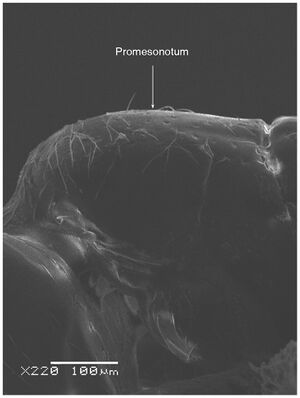Solenopsis sumara
| Solenopsis sumara | |
|---|---|

| |
| Scientific classification | |
| Kingdom: | Animalia |
| Phylum: | Arthropoda |
| Class: | Insecta |
| Order: | Hymenoptera |
| Family: | Formicidae |
| Subfamily: | Myrmicinae |
| Tribe: | Solenopsidini |
| Genus: | Solenopsis |
| Species: | S. sumara |
| Binomial name | |
| Solenopsis sumara Collingwood & Agosti, 1996 | |
The type series was collected from "small crowded nests under stones."
Identification
Sharaf & Aldawood (2012) - Solenopsis sumara is readily distinguished from its relative Solenopsis zingibara by the following characters: head subrectangular; frons without frontal striae; eyes tiny, with two ommatidia; petiolar node in profile massive, high and rounded, in dorsal view clearly broader than long.
Keys including this Species
Distribution
Distribution based on Regional Taxon Lists
Afrotropical Region: Yemen (type locality).
Distribution based on AntMaps
Distribution based on AntWeb specimens
Check data from AntWeb
Countries Occupied
| Number of countries occupied by this species based on AntWiki Regional Taxon Lists. In general, fewer countries occupied indicates a narrower range, while more countries indicates a more widespread species. |

|
Estimated Abundance
| Relative abundance based on number of AntMaps records per species (this species within the purple bar). Fewer records (to the left) indicates a less abundant/encountered species while more records (to the right) indicates more abundant/encountered species. |

|
Biology
Castes
Known only from the worker caste.
Worker
   
| |
| . | |
Nomenclature
The following information is derived from Barry Bolton's Online Catalogue of the Ants of the World.
- sumara. Solenopsis sumara Collingwood & Agosti, 1996: 359 (w.) YEMEN.
- Type-material: holotype worker, paratype workers (number not stated).
- Type-locality: holotype Yemen: Sumara Pass, 2500 m., 7.iii.1993 (C.A. Collingwood); paratypes with same data.
- Type-depository: WMLC.
- Status as species: Sharaf & Aldawood, 2011: 478 (in key); Sharaf & Aldawood, 2012: 14 (redescription); Borowiec, L. 2014: 159.
- Distribution: Yemen.
Unless otherwise noted the text for the remainder of this section is reported from the publication that includes the original description.
Description
Worker
Sharaf & Aldawood (2012) - Lectotype major. TL 2.37; HL 0.62; HW 0.50; SL 0.40; PRW 0.32; EL 0.04; ML 0.62; PL 0.20; PW 0.22; PPL 0.15; PPW 0.20; Indices: SI 80; CI 81.
Paralectotypes (major). TL 1.68–2.48; HL 0.44–0.65; HW 0.36–0.55; SL 0.28–0.42; PRW 0.17–0.35; EL 0.04; ML 0.48–0.65; PL 0.15–0.20; PW 0.12–0.22; PPL 0.11–0.15; PPW 0.12–0.18; Indices: SI 71–83; CI 70–91 (5 measured).
Major. Head subrectangular with nearly parallel sides and narrower anteriorly than posteriorly and slightly but distinctly concave posterior margin; smooth and shining but with widely-spaced punctures; eyes minute, oval with two ommatidia, an upper larger one and a much smaller lower one (originally described as with two-three ommatidia); central clypeal teeth quite prominent and incurved with lateral teeth easily visible in full-face view (originally stated as hardly visible in dorsal view). Promesonotum flat; metanotal groove deep; basal face of propodeum forms a continuous curve with the declivity, which is much longer; spiracle circular. Petiole in profile with a massive and high rounded node and in dorsal view clearly broader than long or scarcely as long as broad; with a short peduncle. Postpetiole little broader than long or as long as broad, with node feebly convex or nearly flat. Pilosity abundant on the head but scarce on pronotum, mesonotum and gaster; propodeum bare or has only one pair of seta. Setae of scape slightly longer than maximum width of scape. Unicolorous dirty yellowish or yellowish brown, with lateral clypeal margins and mandibular teeth reddish yellow. General appearance smooth and shining.
Type Material
Sharaf & Aldawood (2012) - (2) major workers, YEMEN: Sumara Pass, 7.III.1993, 2800 m (sic 2500 in Collingwood & Agosti, 1996) (C. A. Collingwood) (World Museum, Liverpool) [examined, one of the workers is designated here as lectotype ].
In the original description Collingwood and Agosti listed only three specimens, the holotype and two paratypes but no clearly labeled holotype could be found in WMLC and only two specimens with red labels [Sumara Pass, 7.iii.1993, 2800 m] are exist without clear mentioning they are paratypes. It is highly unlikely, that the authors collected exactly two workers for the species, and not more. To prove that we looked for any type materials in the alcohol preserved collection in WMLC and a small tube with six specimens that has the same type locality data was found. The mentioned tube has been identified by Cedric Collingwood (pers. comm.) as containing the type materials, therefore, we believe that the original type series is in existence. We designate a lecotype in this study to unequivocally ascertain the identity of the species Solenopsis sumara. Queens and males are unknown.
References
- Borowiec, L. 2014. Catalogue of ants of Europe, the Mediterranean Basin and adjacent regions (Hymenoptera: Formicidae). Genus (Wroclaw) 25(1-2): 1-340.
- Collingwood, C. A.; Agosti, D. 1996. Formicidae (Insecta: Hymenoptera) of Saudi Arabia (part 2). Fauna Saudi Arab. 15: 300-385 (page 359, worker described)
- Sharaf, M.R. and Aldawood, A.S. 2012. Ants of the genus Solenopsis Westwood 1840 in the Arabian Peninsula with description of a new species, Solenopsis elhawagryi. PloS ONE. 7(11):21 pp. doi:10.1371/journal.pone*Sharaf, M.R., Gotzek, D., Guénard, B., Fisher, B.L., Aldawood, A.S., Al Dhafer, H.M., Mohamed, A.A. 2020. Molecular phylogenetic analysis and morphological reassessments of thief ants identify a new potential case of biological invasions. Scientific Reports 10, 12040 (doi:[https://doi.org/10.1038%2Fs41598-020-69029-4 10.1038/s41598-020-69029-4).
.0049485]

